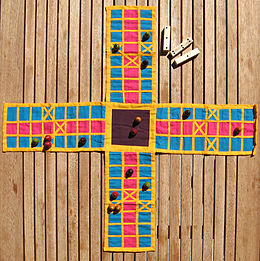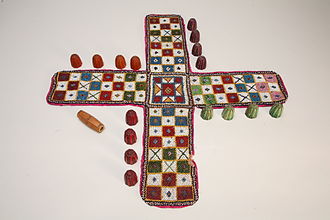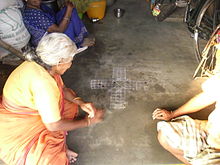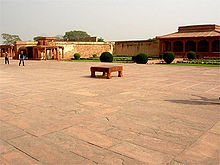
- Tabletop games
- Board games
- Tile-based games
- Turn-based games.html
- Abstract strategy games
- card games
- Connection games
- Mancala games
- Paper-and-pencil games
- Word games




A game of Pachisi on a cloth board
|
|
| Years active | Ancient India to present |
|---|---|
| Genre(s) | Board game Cross and circle game Race game |
| Players | 2-4 |
| Age range | 4+ |
| Playing time | 30-60 minutes |
| Random chance | Medium (dice rolling) |
| Skill(s) required | Strategy, tactics, counting, probability |
| Synonym(s) | Twenty-Five |
Pachisi (Hindi: पचीसी) is a cross and circle board game that originated in ancient India which has been described as the "national game of India". It is played on a board shaped like a symmetrical cross. A player's pieces move around the board based upon a throw of six or seven cowrie shells, with the number of shells resting with aperture upwards indicating the number of spaces to move.
The name of the game derives from the Hindi word pachis, meaning twenty-five, the largest score that can be thrown with the cowrie shells. Thus the game is also known by the name Twenty-Five. There are other versions of this game where the largest score that can be thrown is thirty.
There are other well known versions of the game, chausar, chaupar, chaupur or caupur. The word caupur derives from the Sanskrit catus pada meaning he who has four legs. Parcheesi, Sorry! and Ludo are among the many Westernized commercial versions of the game. It is also possible that this game had led to the development of the Korean board game Yunnori, through the ancient kingdom Baekje.
Pachisi is a game for two, three, or four players, four usually play in two teams. One team has yellow and black pieces, the other team has red and green. The team which moves all its pieces to the finish first, wins the game.
Each player has four beehive-shaped pieces (this can be increased to up to 16 pieces each side in some versions). The pieces of one player are distinguishable from another by their colour: black, green, red and yellow are used for each player.
Six cowrie shells are used to determine the amount to move the players' pieces. The shells are thrown from the player's hand and the number of cowries which fall with their openings upwards indicate how many spaces the player may move:
| Cowries | Value | Another turn? |
|---|---|---|
| 0 | 25 | Yes |
| 1 | 10 | Yes |
| 2 | 2 | No |
| 3 | 3 | No |
| 4 | 4 | No |
| 5 | 5 | No |
| 6 | 6 | Yes |
In some versions, seven cowrie shells are used to determine the amount to move the players' pieces. The shells are thrown from the player's hand and the number of cowries which fall with their openings upwards indicate how many spaces the player may move:
| Cowries | Value | Name | Another turn? |
|---|---|---|---|
| 0 | 7 | Sath | Yes |
| 1 | 10 | Dus | Yes |
| 2 | 2 | Dooga | No |
| 3 | 3 | Theeni | No |
| 4 | 4 | Chari | No |
| 5 | 25 | Pachees | Yes |
| 6 | 35 | Pathees | Yes |
| 7 | 14 | Chaudah | Yes |
The board is usually embroidered on cloth. The playing area is cruciform. There is a large square in the centre, called the Charkoni, which is the starting and finishing position of the pieces. The four arms are divided into three columns of eight squares. The players' pieces are moved along these columns during play.
Twelve squares are specially marked as castle squares. Four of these are positioned at the end of the middle columns of each arm; the other eight are four squares inwards from the end of the outer columns on each arm. A piece may not be captured by an opponent while it lies on a castle square.
 A beaded Pachisi game, The Children's Museum of Indianapolis
A beaded Pachisi game, The Children's Museum of Indianapolis Pachisi being played in Tamil Nadu with Tamarind seeds and stones.
Pachisi being played in Tamil Nadu with Tamarind seeds and stones.Each player's objective is to move all four of their pieces completely around the board, counter-clockwise, before their opponents do. The pieces start and finish on the Charkoni.
The playing order is decided by each player throwing the cowries. The player with the highest score starts, and turns continue counter-clockwise around the board. In some versions, each player throws the cowrie shells and pieces cannot move until a 2, 3, or 4 is thrown.
If a 6, 10 or 25 is thrown, the player gets a grace, which enables the player to introduce one of their pieces from the Charkoni onto the board. The player then repeats his or her turn. In other versions this includes 10, 25, or 30 to introduce another of their pieces, and 7, 14 as a grace without introduction of pieces. A player needs to have at least one piece on the board to be able to throw a 7 or 14.
Each player's first piece may leave the Charkoni on any throw after it has been introduced onto the board. Each player moves their pieces down the centre column of their own arm of the board, then counter-clockwise around the outside columns.
A player may have any number of pieces on the board at one time. Only one piece may be moved with a single throw, or if the player chooses, they can decline to move any piece on a throw. In some versions, a player can move any number of their pieces with a single throw. Also, if the player casts a value higher than they are eligible to move in a single throw, then the player automatically loses that turn.
More than one piece of the same team may occupy a single square(not true for all squares in some versions). However a piece may not move onto a castle square that is already occupied by an opponent's piece.
If a piece lands on a square (other than a castle square) occupied by any number of the opponent's pieces, those pieces are captured/killed and must return to the Charkoni. Captured pieces may only enter the game again with a grace throw. A player making a capture is allowed another turn (not true in some versions).
In some versions, a player cannot take their pieces back to the Charkoni/home, unless they have captured/killed at least one of the opponent's pieces. Some versions have a rule where if, for example, two players are playing against each other, and Player 1 captures a piece of Player 2. If Player 2, in their immediate turn after being captured for the first time, captures the same piece Player 1 just used to capture, in the same square where the capture took place, then Player 1's capture/kill is invalidated. Player 1 will need to recapture Player 2's piece again to be able to go back to the Charkoni, but Player 2 is free to go ahead to their respective Charkoni, unless the above repeats.
A piece completes its trip around the board by moving back up its central column. Returning pieces may be placed on their side in order to distinguish them from pieces that have just entered. A piece can only return to the Charkoni by a direct throw.
Four of the castle squares are placed so they are exactly 25 moves from the Charkoni. A common strategy is for returning pieces to stay on these squares, where they are safe from capture, until a 25 is thrown. The pieces can then finish the game directly. This is where the name of the game comes from.
In some versions, where more emphasis is put on the throwing of the cowries, experienced players can cause cowries land in a specific way, there are certain other rules to make the game more exciting.
Pachisi may be quite ancient, but so far its history has not been established prior to the 16th century. A 6th- or 7th-century representation of Lord Shiva and the Goddess Parvati said to be playing Chaupar (a closely related game) in fact depicts only dice and not the distinctive board. A Song Dynasty (960-1279) document referencing the Chinese game ch'u-p'u 樗蒲 (Wade-Giles, pinyin chupu), "invented in western India and spread to China in the time of the Wei Dynasty (AD 220-265)" may relate to Chaupar, but the actual nature of the Chinese game (which may be more closely related to backgammon) is uncertain. Speculation that Pachisi derived from the earlier game of Ashtapada is plausible but unsubstantiated.
 Large ancient garden version - Fatehpur Sikri - India
Large ancient garden version - Fatehpur Sikri - IndiaAt the 16th-century palace at Fatehpur Sikri in northern India:
The game of Pachisi was played by Akbar in a truly regal manner. The Court itself, divided into red and white squares, being the board, and an enormous stone raised on four feet, representing the central point. It was here that Akbar and his courtiers played this game; sixteen young slaves from the harem wearing the players' colours, represented the pieces, and moved to the squares according to the throw of the dice. It is said that the Emperor took such a fancy to playing the game on this grand scale that he had a court for pachisi constructed in all his palaces, and traces of such are still visible at Agra and Allahabad.
Finkel adds:
To date, these grandiose boards still represent the earliest secure evidence for the existence of the game in India. The game's role in the history of India still remains to be investigated. It is often assumed that the gambling game that plays so significant a role in the Mahabharata, the classical literary epic, is pachisi, but the descriptions, such as they are, do not tie in with the game, and this conclusion is perhaps erroneous.